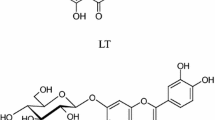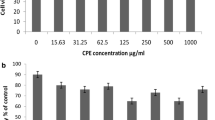Abstract
Flavonoids, a group of low molecular weight phenylbenzopyrones, have various pharmacological properties including antioxidant activity, anticancer, and immunomodulatory effects. In the present study, lipopolysaccharide (LPS) and phorbol 12-myristate 13-acetate/phytohemagglutinin (PMA/PHA) were used as stimulants for RAW 264.7 macrophages and human peripheral blood mononuclear cell (hPBMC), and tumor necrosis factor (TNF)-a and interleukin (IL)-2 productions were measured. In addition, flavonoids were examined for their effects on LPS-induced NO production in RAW 264.7 macrophages. The results showed that all compounds were not strongly cytotoxic at the tested concentrations on hPBMC and RAW 264.7 macrophages. On immunomodulatory properties, catechin, epigallocatechin (EGC), naringenin, and fisetin repressed NO production and TNF-a secretion. Furthermore, catechin, epigallocatechin gallate (EGCG), epicatechin (EC), luteolin, chrysin, quercetin, and galangin increased IL-2 secretion while EGC, apigenin, and fisetin inhibited the secretion. These results indicated that flavonoids have the capacity to modulate the immune response and have a potential anti-inflammatory activity. There was no obvious structure-activity relationship regard to the chemical composition of the flavonoids and their cell biological effects.
Similar content being viewed by others
References
Andreakos, E. T., Foxwell, B. M., Brennan, F. M., Maini, R. N., and Feldmann, M., Cytokines and anti-cytokine biologicals in autoimmunity: present and future.Cytokine Growth Factor Rev., 13, 299–313 (2002).
Bors, W., Heller, W., Michel, C., and Saran, M., Radical chemistry of flavonoid antioxidants.Adv. Exp. Med. Biol., 264, 165–170 (1990).
Chiou, W. F., Sung, Y. J., Liao J. F., Shum A. Y., and Chen C. F., Inhibitory effect of dehydroevodiamine and evodiamine on nitric oxide production in cultured murine macrophages.J. Nat. Prod., 60, 708–711 (1997).
Haraoui, B., Pelletier, J. P., Cloutier, J. M., Faure, M. P., and Martel-Pelletier, J., Synovial membrane histology and immunopathology in rheumatoid arthritis and osteoarthritis.In vivo effects of antirheumatic drugs.Arthritis Rheum., 34, 153–163 (1991).
lalenti, A., Moncada, S., and Di, R. M., Modulation of acute inflammation by endogenous nitric oxide.Eur. J. Pharmacol., 211, 177–182 (1992).
Kobuchi, H., Droy-Lefaix, M. T., Christen, Y., and Packer, L., Ginkgo biloba extract (Egb 761): Inhibitory effect on nitric oxide production in the macrophage cell line RAW 264.7.Biochem. Pharmacol., 53, 897–903 (1997).
Kovacs, E., Serum levels of IL-12 and the production of INF-gamma, IL-2 and IL-4 by peripheral blood mononuclear cells (PBMC) in cancer patients treated withViscum album extract.Biomed. & Pharmacother., 54, 305–310 (2000).
Leonard, W., Chapter 21: Type I cytokines and interferon and their receptors. InPaul W. E. (Eds.).Fundamental immunology.Raven Publishers, Philadelphia, U.S.A., pp. 745–747 (1999).
Li, O. and Verma, I. M., NF-kappa B regulation in the immune system.Nat. Rev. Immunol., 2, 725–734 (1992).
Middleton Jr., E., Kandaswami, C., and Theoharides, T. C., The effects of plant flavonoids on mammalian cells: implications for inflammation, heart disease, and cancer.Pharmacol. Rev., 52, 673–751 (2001).
Mingari, M. C., Gerosa, F., Carra, G., Accolla, R. S., Moretta, A., Zubler, R. H., Waldmann, T. A., and Moretta, L., Human interleukin-2 promotes proliferation of activated B cellsvia surface receptors similar to those of activated T. cells.Nature, 312, 641–643 (1984).
Park, Y. C., Rimbach, G., Saliou, C., Valacchi, G., and Packer, L., Activity of monomeric, dimeric, and trimeric flavonoids on NO production, TNF-α secretion, and NF-kB-dependent gene expression in RAW 264.7 macrophages.FEBS Lett., 465, 93–97 (2000).
Radford-Smith, G. and Jewell, D. P., Cytokines and inflammatory bowel disease.Baillieres Clin. Gastroenterol., 10, 151–164 (1996).
Rice-Evans, C. A., Miller, N. J., Bolwell, P. G., Bramley, P. M., and Pridham, J. P., The relative antioxidant activities of plant-derived polyphonolic flavonoids.Free Radical Res. Commun., 22, 375–383 (1995).
Rimbach, G., Virgili, F., Park, Y. C., and Packer, L., Effect of procyanidins from Pinus maritima on glutathione levels in endothelial cells challenged by 3-morpholinosydnonimine or activated macrophages.Redox Rep., 4, 171–177 (1999).
Robak, J. and Gryglewski, R. J., Flavonoids are scavengers of Superoxide anions.Biochem. Pharmacol., 37, 837–841 (1988).
Robertson, M. J. and Ritz, J., Biology and clinical relevance of human natural killer cells.Blood, 76, 2421–2438 (1990).
Ryu, J. H., Lee, H. J., Jeong, Y. S., Ryu, S. Y., and Han, Y. N., Yomogin, an inhibitor of nitric oxide production in LPS-activated macrophages.Arch. Pharm. Res., 21, 481–484 (1998).
Sandoval, M., Charbonnet, R. M., Okuhama, N. N., Roberts, J., Krenova, Z., Trentacosti, A. M., and Miller, M. J., Cat’s claw inhibits TNFalpha production and scavenges free radicals: role in cytoprotection.Free Radical Biol. Med., 29, 71–78 (2000).
Stichtenoth, D. O. and Frolich, J. C., Nitric oxide and inflammatory joint diseases.Br. J. Rheumatol., 37, 246–247 (1998).
Waldmann, T. A., Goldman, C. K., Robb, R. J., Depper, J. M., Leonard, W. J., Sharrow, S. O., Bongiovanni, K. F., Korsmeyer, S. J., and Greene, W. C., Expression of interleukin 2 receptors on activated human B cells.J. Exp. Med., 160, 1450–1466 (1984).
Williams, G., Brown, T., Becker, L., Prager, M., and Giroir, B. P., Cytokine-induced expression of nitric oxide synthase in C2C12 skeletal muscle myocytes.Am. J. Physiol., 267, R1020–1025 (1994).
Wiseman, H., Role of dietary phyto-oestrogens in the protection against cancer and heart disease.Bio. Comp. Food, 24, 795–800 (1996).
Xie, Q. W., Whisnant, R., and Nathan, C., Promoter of the mouse gene encoding calcium-independent nitric oxide synthase confers inducibility by interferon gamma and bacterial lipopolysaccharide.J. Exp. Med., 177, 1779–1784 (1993).
Author information
Authors and Affiliations
Corresponding author
Rights and permissions
About this article
Cite this article
Lyu, SY., Park, WB. Production of Cytokine and NO by RAW 264.7 Macrophages and PBMC In Vitro Incubation with Flavonoids. Arch Pharm Res 28, 573–581 (2005). https://doi.org/10.1007/BF02977761
Received:
Issue Date:
DOI: https://doi.org/10.1007/BF02977761




